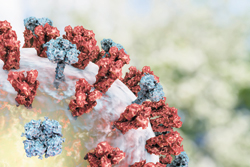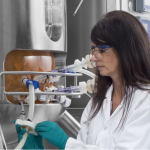
This article summarizes the approaches, challenges, and future perspectives for the characterization of N-glycans in biopharmaceutical products. By Aled Jones
Protein glycosylation, the addition of single sugars or oligosaccharide chains (glycans) to a peptide backbone, is a common post-translational modification (PTM) that imparts various biological functions (1). More than half of all biotherapeutics are glycosylated (2), including monoclonal antibodies (mAbs), Fc-fusion proteins, clotting factors, and cytokines such as erythropoietin. Of these, mAbs represent a large proportion of biotherapeutic glycoproteins and account for approximately half of the biopharmaceutical market, a trend that is set to continue with the advent of biosimilars and biobetters (3, 4). N-Glycosylation, where glycans are attached to the nitrogen side chain of asparagine, is perhaps the most well understood form of glycosylation in biotherapeutics, particularly on mAbs, in which the N-glycan structure can affect pharmacokinetics, pharmacodynamics, and immunogenicity (5). The impact of glycosylation on protein function means that glycosylation can be a critical quality attribute (CQA), making the characterization of N-glycan structures an essential part of the biotherapeutic development process. The complex, branched structure of N-glycans present a unique analytical challenge. A variety of approaches exist, each with their own advantages and limitations. In this article, the biological effects of N-glycosylation on protein biologics are reviewed—together with the range of analytical techniques that are used to elucidate the N-glycosylation characteristics of protein biotherapeutics–and future directions for glycoanalysis are discussed.
N-glycosylation
The flow of biological information in the DNA-RNA-protein central dogma of molecular biology (6) is complemented by a repertoire of PTMs including phosphorylation, lipidation, N-acetylation, ubiquitination, and glycosylation–the attachment of carbohydrate structures (oligosaccharides) to proteins to form glycoproteins. As of 2011, it is estimated that approximately one-fifth of the proteins on the Swiss-Prot database are glycoproteins (1). Glycosylation affects a variety of protein biological functions including folding, stability, and activity. These varied functions are enabled by the structural diversity of glycans, which stem from monosaccharide building-block composition, linkage type, and branching (7). The most prevalent forms of glycosylation are N-linked, where oligosaccharides are attached via the side-chain amino moiety (-NH2) of asparagine, and O-linked, where the sugars attach via the hydroxyl moiety (-OH) of serine or threonine. N-linked glycosylation is generally of the most frequent interest to biotherapeutic research–with a notable mention for the O-glycans present on the linker region of Enbrel (etanercept) (8). N-Glycosylation usually occurs where a protein contains the consensus sequence motif, N-X-S/T where X is not proline, although non-consensus N-linked glycosylation has been observed where the sequon is reversed (9).
Lack of market uptake?
Noticeably, sales of biosimilars have not been as high compared to innovator biologics, despite being on the market for years, Bukhari remarks.This points to less-than-stellar uptake.
Gabrielson agrees, stating that market uptake has not met expectations in certain cases. This is partly due to the hesitancy among doctors and patients regarding the difference between biosimilarity and interchangeability, both Bukhari and Gabrielson specify.
“I think [this perception] is unique in the US market compared to other areas of the world,” Gabrielson says. “In the US, a biosimilar can be approved as a biosimilar without being interchangeable, or it can be approved as a biosimilar that is interchangeable, [which requires] switching studies as part of the clinical arms of the biosimilar approval, at least in some cases, to demonstrate that the product is, in fact, interchangeable.”
Gabrielson, however, considers that it may be a mistake to allow these two conditions of biosimilar approval in the US (i.e., biosimilar approved without interchangeability or biosimilar approved with interchangeability). “I feel like what [has been] created is two classes of biosimilars in the US market, where some are judged to be of ‘higher’ quality because they’re interchangeable, which wasn’t the intention. … A better model would be one where any biosimilar that’s approved, that goes through the rigorous approval process, by regulators in the US or elsewhere is automatically deemed to be interchangeable with its reference product, similar to the EU designation system. I think that would ease the burden,” Gabrielson says.
Easing the way for market uptake of biosimilars also requires discussion, Gabrielson notes. There is a need for discussion between patients and doctors and alignment among physicians with a goal toward raising the comfort level in prescribing biosimilars in lieu of the innovator product. The responsibility in changing the misperception that there exists a tier of “higher-quality” biosimilars falls upon multiple areas.
“It’s not a single organization or even a single sector that needs to take the lead in this. It’s about multiple groups working together to really change that mindset,” says Gabrielson. Certainly, the industry needs to take a role as well as regulators, he adds. Furthermore, he believes that Congress may also need to step in and change the underlying law that dictates interchangeability.
“[Interchangeability] is built into federal and state laws, which doesn’t provide FDA with as much flexibility as is needed,” Gabrielson states, going on to say, “but most of it really comes down to education.” Gabrielson specifies that education is needed in terms of: how to educate physicians on what biosimilars are, their quality, how rigorously they’re tested to ensure that they are safe and efficacious; and that, if a biosimilar doesn’t have the interchangeability designation, it is still a safe and effective treatment.
“Much of it really is just education materials that can be created by, for example, trade organizations or companies speaking to physicians, and, ultimately, even directly to patients,” Gabrielson says.
Dealing with challenges
Other hurdles to bringing a biosimilar to market include the availability of the reference biologic and the batch-to-batch variability of that reference product; this is on top of the complexity of the molecule, notes Bukhari. “[Furthermore,] since you’re dealing with biologics, you cannot have exact true copies,” she adds. “The process and manufacturing aspect of it is patented, it’s not released. So, [a biosimilar developer] would need to figure it out [for themselves] and understand the process, and make it cost effective, all at the same time.”
Add to that the time it takes to bring a biosimilar to market and the challenge of navigating the regulatory pathways. “As mentioned earlier, [companies] have to provide much more CMC [chemistry, manufacturing, and controls] data for biosimilars compared to the innovator, and that takes time. [Companies] have to establish more steps, and need to have much more stability data available to show that [the biosimilar] product is actually doing what it is supposed to do,” Bukhari explains.
Another hindrance to progress is the ideology of adopting the innovation aspect and including it to justify one’s data to FDA, Bukhari adds. “Say [a company has] taken up an innovative method to produce a biosimilar, then that method also has to be validated. That validation data also has to be given to FDA, and that requires more time and cost,” she says.
“When we think about what it takes to bring a biosimilar to market compared to what it takes to bring an innovative product to market, of course, there’s a much lower clinical barrier, fewer clinical requirements. [It’s] abbreviated for a biosimilar,” says Gabrielson. However, Gabrielson clarifies, what most people don’t realize is that the amount of data from a CMC perspective, and particularly data demonstrating analytical similarity, is the same or higher than what it would take to bring an innovative product to market.
“There’s so much work that goes into demonstrating, analytically, that a product is comparable or similar to its reference product in order to achieve that type of regulatory approval,” Gabrielson states.
On the pricing pressure aspect in the biopharma market, Gabrielson asserts that pricing pressure is a central theme in biosimilars. “That is why these products exist, fundamentally,” he remarks, “to make life-changing medicines more available, more accessible, and more affordable to patients throughout the world. I think it makes sense that there is pricing pressure in this market, because I think everyone’s goal with this is to make medication more affordable to patients.” Thus, rather than a hindrance, and rather than existing in a mindset where developers need to find a way to overcome pricing pressure, Gabrielson points to pricing pressure on the market as the reality, and should be perceived as such.
“It’s a feature of the system, not a bug,” Gabrielson states, explaining that what biosimilar developers need to be doing is figuring out creative and innovative ways to build businesses that can be successful in an environment where there is going to be sustained, consistent pricing pressure. “Pricing pressure can come from lower priced, brand name biologics when they come off patent, it can come from competing biosimilars, but that’s the market. It’s not exactly like the generics market, but there are some parallels between what [is being seen] with biosimilars and what [has] already [been] seen with generics in terms of that pricing pressure. So, a good question that really needs to [be] asked [of] developers is, how is [a] particular product viable commercially, and even differentiated in the marketplace, in the face of this type of competition?”
Reference
1. FDA. FDA Approves First Biosimilar Product Zarxio. Press Release, March 6, 2015.
About the author
Feliza Mirasol is the science editor for BioPharm International.
Article Details
BioPharm International
Volume 37, No.3
March 2024
Pages: 8–9,29
Citation
When referring to this article, please cite it as Mirasol, F. Moving Biosimilars Forward in a Hesitant Market. BioPharm International 2024, 37 (3), 8–9,29.





